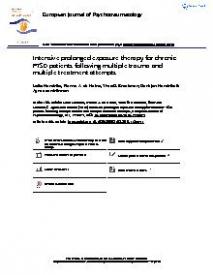Intensive prolonged exposure therapy for chronic PTSD patients following multiple trauma and multiple treatment attempts
ABSTRACT
Background: Suboptimal response and high dropout rates leave room for improvement of trauma-focused treatment (TFT) effectiveness in ameliorating posttraumatic stress disorder (PTSD) symptoms.
Objective: To explore the effectiveness and safety of intensive prolonged exposure (iPE) targeting chronic PTSD patients with a likely diagnosis of ICD-11 Complex PTSD following multiple interpersonal trauma and a history of multiple treatment attempts.
Method: Participants (N = 73) received iPE in 12 × 90-minute sessions over four days (intensive phase) followed by four weekly 90-minute booster prolonged exposure (PE) sessions (booster phase). The primary outcomes, clinician-rated severity of PTSD symptoms, and diagnostic status (Clinician-Administered PTSD Scale; CAPS-IV) were assessed at baseline, post-treatment, and at three and six months. Treatment response trajectories were identified and predictors of these trajectories explored.
Results: Mixed model repeated measures analysis of CAPS-IV scores showed a baseline-to-posttreatment decrease in PTSD symptom severity (p < .001) that persisted during the three- and six-month follow-ups with large effect sizes (Cohen’s d > 1.2); 71% of the participants responded. None of the participants dropped out during the intensive phase and only 5% during the booster phase. Adverse events were extremely low and only a minority showed symptom exacerbation. Cluster analysis demonstrated four treatment response trajectories: Fast responders (13%), Slow responders (26%), Partial responders (32%), and Non-responders (29%). Living condition and between-session fear habituation were found to predict outcome. Participants living alone were more likely to belong to the Partial responders than to the Non-responders cluster, and participants showing more between-session fear habituation were more likely to belong to the Fast responders than to the Non-responders cluster.
Conclusions: The results of this open study suggest that iPE can be effective in PTSD patients with multiple interpersonal trauma and after multiple previous treatment attempts. In addition, in this chronic PTSD population iPE was safe.
In: European Journal of Psychotraumatology, ISSN 2000-8198 ; eISSN 2000-8066 | 9 | 1 | 1425574
https://doi.org/10.1080/20008198.2018.1425574


